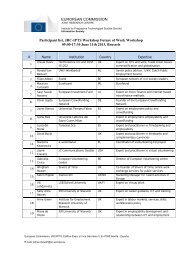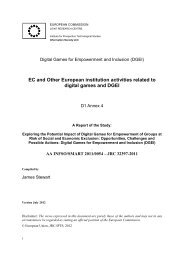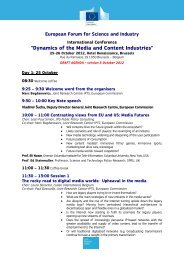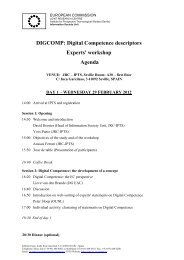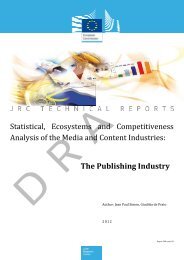Web 2.0 for eGovernment - IPTS - JRC - Europa
Web 2.0 for eGovernment - IPTS - JRC - Europa
Web 2.0 for eGovernment - IPTS - JRC - Europa
You also want an ePaper? Increase the reach of your titles
YUMPU automatically turns print PDFs into web optimized ePapers that Google loves.
<strong>Web</strong> <strong>2.0</strong> <strong>for</strong> <strong>eGovernment</strong>:<br />
why and how?
David Osimo, Clara Centeno,<br />
Jean-Claude Burgelman<br />
<strong>JRC</strong> - <strong>IPTS</strong><br />
European Commission
Setting the scene: web <strong>2.0</strong> in the<br />
<strong>eGovernment</strong> context
Key objectives of government modernization<br />
• Simple and user-oriented<br />
• Participative and inclusive<br />
• Transparent and accountable<br />
• Joined-up and networked<br />
• Efficient and innovative<br />
ICT as a strategic instrument to achieve this
100<br />
90<br />
80<br />
70<br />
60<br />
50<br />
40<br />
30<br />
20<br />
10<br />
0<br />
But still challenges lie ahead…<br />
Interactive government services (EU25 - 2006)<br />
50<br />
9,3<br />
% services fully interactive % citizens using them<br />
Source: Eurostat, CGEY<br />
How can web<strong>2.0</strong><br />
contribute?
The e-ruptive growth of user-driven applications<br />
70 M blogs,<br />
doubling every 6 months<br />
Wikipedia: 2M articles<br />
Source: Technorati, Alexa, Wikipedia, Cachelogic<br />
YouTube traffic: 100M views/day<br />
Peer-to-peer largest<br />
source of IP traffic
Key application areas in egovernment,<br />
and examples<br />
Based on extrapolation of :<br />
• existing initiatives in the public<br />
sector,<br />
• applications in private sector,<br />
• trends in government
Identified areas of application (a rolling list)<br />
Regulation<br />
Back office<br />
Cross-agency collaboration<br />
Knowledge management<br />
Interoperability<br />
Human resources mgmt<br />
Public procurement<br />
Front office<br />
Service delivery<br />
eParticipation<br />
Law en<strong>for</strong>cement<br />
Public sector in<strong>for</strong>mation<br />
Public communication<br />
Transparency and accountability<br />
Innovation<br />
Inclusion<br />
Networked Employees Networked Citizens
Regulation case: Peer-to-patent
Peer-to-patent: an inside look<br />
Governance<br />
• Partnership of US Patent Office with business and academia<br />
(NY Law school)<br />
• Self-appointed experts, but participants ensure relevance and<br />
quality by tagging, ranking prior art, ranking other reviewers<br />
• Desire of recognition as participation driver<br />
• Weak authentication: blog style<br />
Usage: Started June 07. 1000 users, 32 submission in first month.<br />
Benefits<br />
• Faster processes, backlog reduction<br />
• Better in<strong>for</strong>med decisions<br />
Other applications:<br />
• Functions where governments have “to make complex decisions<br />
without the benefit of adequate in<strong>for</strong>mation”.
Cross agency collaboration case: Intellipedia<br />
• Based on Wikipedia software: collaborative drafting of joint reports<br />
Governance<br />
• Used by 16 US security agencies – on a super-secure intranet (not<br />
public)<br />
• Flat, in<strong>for</strong>mal cooperation.<br />
• Risks: too much in<strong>for</strong>mation sharing. BUT it’s “worth it”: "the key is risk<br />
management, not risk avoidance.“<br />
Usage: fast take-up, two thirds of analysts use it to co-produce reports<br />
Benefits<br />
• Avoiding silos effects (post 9-11)<br />
• Better decisions by reducing in<strong>for</strong>mation bottlenecks<br />
Other applications:<br />
• Social services <strong>for</strong> homeless (Canada, Alaska)<br />
• Inter-agency consultation<br />
• Environmental protection and disaster management (US-EPA,<br />
earthquake in Japan)
Knowledge management case: Allen and Overy<br />
Answering key questions…<br />
• Which articles do managers think<br />
are important this morning?<br />
• Which newsfeeds do my favorite<br />
colleagues use?<br />
• What discussion topics are hot in<br />
a project team (things you can’t<br />
anticipate)?<br />
• Who is expert/working on this<br />
specific topic/tag?<br />
…by using “Enterprise <strong>2.0</strong>” tools:<br />
• Blogs and wikis <strong>for</strong> discussion and<br />
collaboration<br />
• Collaborative filtering of in<strong>for</strong>mation,<br />
recommendation systems,<br />
bookmarks sharing (tags, RSS<br />
feeds)<br />
• On top of this: algorithms applied to<br />
users’ attention data and behaviour<br />
Not yet spread in companies – but used by individual workers
Allen and Overy: an inside look<br />
Governance<br />
• Pilot launched on small collaborative groups – then upscaled<br />
• Fast, iterative delivery (not big IT project approach)<br />
• Strong authentication (integrated with company SSO)<br />
• Kept the wiki spirit, low control (non sensitive content)<br />
Usage: became internal standard <strong>for</strong> collaboration and sharing<br />
Benefits<br />
• Increased awareness of what others are doing – less duplication of<br />
ef<strong>for</strong>t<br />
• Reduction in internal e-mail sent<br />
• Better learning and knowledge creation<br />
Other applications<br />
• All knowledge-intensive areas of government
Service delivery case: Patient Opinion
Patient Opinion: an inside look<br />
Governance<br />
• Launched by a GP as a social enterprise: third party between<br />
government and citizen<br />
• Start-up funded by NHS, now revenues from health providers<br />
subscribing to the service<br />
• Strong moderation (but also from senior patient)<br />
• Weak authentication (blog-style) to enhance ease-of-use<br />
Usage: 3000 comments in 9 months, 38 health providers subscribed<br />
Benefits of ratings/reviews<br />
• Enabling in<strong>for</strong>med choices (<strong>for</strong> citizens)<br />
• Understanding users needs (<strong>for</strong> government)<br />
• Monitoring quality compliance <strong>for</strong> service improvement<br />
Other applications in service delivery<br />
• Citizens provide themselves additional services (Netmums.com,<br />
Katrinalist)<br />
• New channels through mash-up (my homepage as government onestop-shop)
Reminder: citizens and employees do it anyway
eParticipation case: e-petitions in UK
E-Petitions: an inside look<br />
Governance<br />
• Hosted in the PM website, run by NGO MySociety.org (fixmystreet.com,<br />
theywork<strong>for</strong>you.com, planningalerts.com etc.)<br />
• Ex-post moderation (nearly all petitions are listed)<br />
• Weak authentication (blog-style)<br />
• Launched as beta, 15 major changes in first 48 hours<br />
Usage: 2.1M individuals signed petitions in 6 months<br />
Benefits<br />
• Stimulates citizen participation<br />
• Real impact on current legislative process<br />
• Especially effective in agenda-setting<br />
Other applications: eParticipation, not only campaigning<br />
• Bringing citizens participation upstream: commentonthis.com,<br />
• Monitoring public representatives: theywork<strong>for</strong>you.com<br />
• Easy creation of pressure groups even <strong>for</strong> specific causes: change.org;<br />
• All this mostly outside government websites
Law en<strong>for</strong>cement case: MyBikeLane
Lessons learnt<br />
Based on evidence presented so<br />
far, and additional experts’<br />
interviews
<strong>Web</strong> <strong>2.0</strong> in <strong>eGovernment</strong>: why?<br />
• Supports objectives of re<strong>for</strong>med government<br />
• Simple and user-oriented<br />
• Participative and inclusive<br />
• Transparent and accountable<br />
• Joined-up and networked<br />
• Efficient and innovative<br />
• And citizens can help!
Different kinds of citizens’ involvement in web <strong>2.0</strong><br />
1.Producing content<br />
2.Providing ratings, reviews<br />
3.Using user-generated content<br />
4.Providing attention, taste data<br />
3% 10%<br />
40% 100% of Internet users (50% of EU population)<br />
Source: <strong>IPTS</strong> estimation based on Eurostat, IPSOS-MORI, Forrester
Why? /2<br />
• Citizens (and employees) already use web <strong>2.0</strong>:<br />
no action ≠ no risks<br />
• Likely to stay as it is linked to underlying societal<br />
trends<br />
• Today’s teenagers = future users and employees<br />
• Empowered customers<br />
• Creative knowledge workers<br />
• From hierarchy to network-based organizations<br />
• Non linear-innovation models<br />
• Consumerization of ICT
How to start: suggestions from web<strong>2.0</strong> experts<br />
• Start from back office: knowledge intensive,<br />
collaborative culture teams<br />
• Evaluate existing usage by your employees<br />
• Partner with civil society and existing initiatives<br />
• Open your data, make them available <strong>for</strong> re-use<br />
• Provide governance, but soft: policies and guidance<br />
• Listen and follow-up on users’ feedback<br />
• But no ready recipes: experiment through robust<br />
beta (it’s cheap), learn by doing
Common mistakes<br />
• “Build it and they will come”: beta testing, trial and<br />
error necessary<br />
• Doing everything on own website: reach out through<br />
existing websites/network<br />
• Opening up without soft governance of key<br />
challenges:<br />
• privacy<br />
• individual vs institutional role<br />
• destructive participation<br />
• Adopting only the technology with traditional topdown<br />
attitude
<strong>Web</strong> <strong>2.0</strong> is about both technology and attitude<br />
Attitude<br />
Technology<br />
User as producer, collective intelligence, open<br />
content, perpetual beta, ease of use<br />
Blogs, Podcast, Wiki, Social Networking, Peer-topeer,<br />
MPOGames, Mash-up<br />
Ajax, Micro<strong>for</strong>mats, RSS/XML
Conclusion: start experimenting with web <strong>2.0</strong><br />
• Several application areas – complementary to<br />
existing solutions<br />
• Helpful <strong>for</strong> long-desired <strong>eGovernment</strong> goals, also<br />
through users involvement<br />
• Rooted in long-term societal trends: individuals (and<br />
not only IT specialists) are doing it anyway<br />
• Not a commodity: needs leadership, creativity,<br />
learning-by-doing
Thanks<br />
david.osimo@ec.europa.eu<br />
http://is.jrc.es




